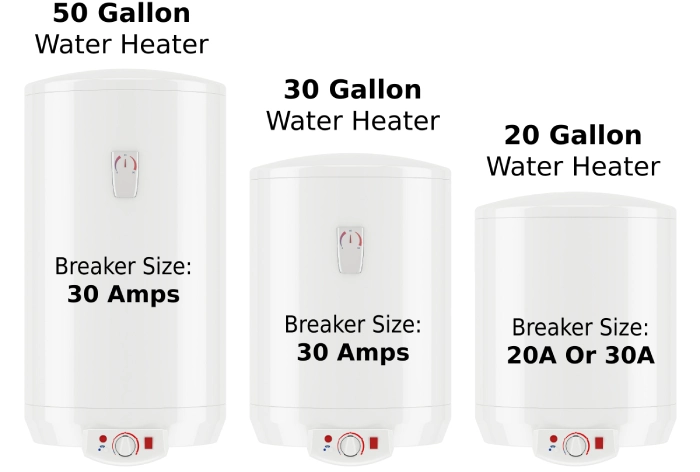Are you considering upgrading your water heater or troubleshooting an issue with your existing unit? One crucial aspect that often gets overlooked is the circuit breaker size.
Choosing the right circuit breaker size isn’t just a technical detail; it’s essential for your safety, efficiency, and the longevity of your water heater. Imagine the peace of mind knowing your home is safeguarded against electrical mishaps. This article will guide you through everything you need to know about selecting the perfect circuit breaker size for your water heater.
Stick around to ensure you’re making the best choice for your home and your wallet.

Credit: 5-starplumbing.com
Page Contents
Understanding Circuit Breakers
Circuit breakers help keep homes safe. They stop too much electricity. This prevents fires. Electricity can be dangerous. A circuit breaker acts like a switch. It turns off power if needed. It protects your home and your family.
There are different types. Single-pole breakers are common in homes. They control one wire. Double-pole breakers handle more power. They control two wires. GFCI breakers are special. They protect in wet areas like bathrooms. AFCI breakers stop fires from bad wiring. Each type has a special job. Knowing these helps you choose the right one.
Water Heater Specifications
Voltageand wattageare important for water heaters. Most heaters need a voltage of 240 volts. Some smaller units might work on 120 volts. Knowing the wattage is also crucial. Typical water heaters use 3,000 to 4,500 watts.
Check these numbers in your heater’s manual. This helps you decide on the right circuit breaker size. Using the wrong breaker can be risky. Always ensure your setup matches the heater’s needs.
Calculating Circuit Breaker Size
Find the correct circuit breaker size by using a simple formula. First, look at the watts on your water heater. Divide the watts by the volts. This gives you the amps. Next, multiply the amps by 125%. This ensures safety. This new number is your circuit breaker size.
Correct calculations keep your home safe. If the breaker is too small, it might trip often. If it’s too big, it could cause a fire. Always double-check your numbers. Safety comes first. Using the right size saves money on repairs. It also keeps your water heater working well.

Credit: www.bennettcelticart.com
Common Mistakes
Using an oversized breakercan be risky. It might not trip when needed. This can cause wires to overheat. Overheating leads to fires. A breaker must match the heater’s power needs. Always check the heater’s specifications. Choose the right breaker size. Safety first!
An undersized breakertrips too often. This can be annoying. It interrupts hot water supply. An undersized breaker can’t handle the heater’s power. This leads to constant trips. Always check the power rating. Choose a breaker that matches the heater. This ensures smooth operation.
Installation Tips
Always turn off the power before starting. Electricity is dangerous. Wear rubber gloves for safety. Keep water away from electrical parts. Use tools with insulated handles. Double-check the connections. Make sure wires are not frayed. Safety comes first in every step.
Sometimes, things get tricky. Electricians know best about circuits. They ensure everything is safe. Hiring a professional saves time. It can prevent accidents. Electricians are trained for these tasks. They have special tools. They can check your work. Peace of mind comes with their help.
Troubleshooting Issues
Frequent trippingof the water heater circuit breaker can be frustrating. This might be due to a faulty breakeror an overloaded circuit. Sometimes, a short circuitcould be the cause. Check if the water heater is drawing too much power. Inspect the wiring for any visible damage. Loose connections can lead to tripping too. Ensure the breaker size matches the heater’s requirements. A breaker that’s too small will trip more often.
Malfunctioning water heaterscan show various signs. Cold water instead of hot is one sign. Another is unusual noisesfrom the heater. Rusty water can indicate internal damage. Leaks around the heater need immediate attention. If the heater struggles to maintain temperature, it might be faulty. Frequent tripping of the breaker is also a concern. Regular maintenance can prevent these issues.

Credit: structuretech.com
Frequently Asked Questions
What Size Breaker For A Water Heater?
The standard breaker size for most water heaters is 30 amps. It’s crucial to match the breaker size with your specific heater’s electrical requirements. Always consult your water heater’s manual or a professional electrician for guidance to ensure safety and optimal performance.
Why Is Breaker Size Important?
Breaker size is vital for safety and efficiency. An incorrect breaker can lead to overheating or electrical hazards. It ensures the water heater receives the correct electrical load. Always use the recommended size to prevent potential damage or fire risks.
How Do I Determine Breaker Size?
To determine breaker size, check your water heater’s wattage and voltage. Divide the wattage by the voltage to find the amperage. Use this number to select the appropriate breaker. Consulting an electrician ensures accurate calculations and safety compliance.
Can I Use A 20 Amp Breaker?
Using a 20 amp breaker for a water heater is generally not recommended. Most water heaters require a 30 amp breaker for safe operation. A smaller breaker may not provide sufficient power, leading to tripping or potential damage. Always follow manufacturer guidelines for breaker size.
Conclusion
Choosing the right circuit breaker size is crucial for safety. It ensures your water heater operates efficiently without risks. Always consider the heater’s wattage and voltage. Consult the manufacturer’s specifications. This helps you select the correct breaker. A wrong size can lead to overheating or tripped circuits.
Seek professional advice if unsure. Electricians can help you make the right choice. Regular checks on your breaker can prevent issues. Safety and efficiency go hand in hand. Prioritize understanding your home’s electrical needs. This way, you ensure a safe and functional water heating system.
